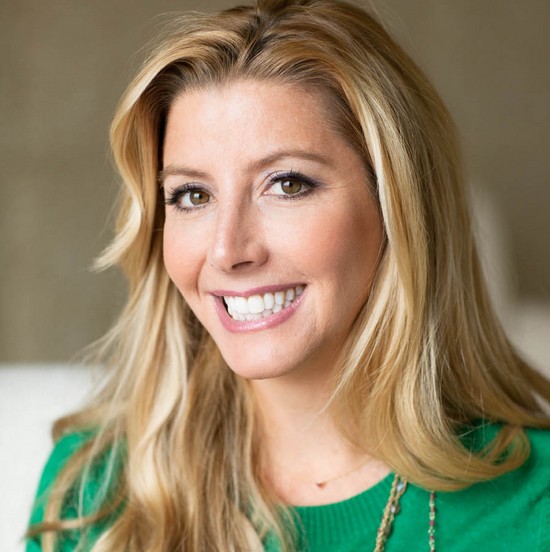For the cover of our recent World’s Billionaires issue, I profiled Sara Blakely, who took a simple idea — footless pantyhose — and turned it into a $1 billion business. At 41, the inventor of Spanx is now the youngest self-made woman on the Forbes rich list.

Since our first meeting last summer, I’ve logged hours of interview time with the Florida-born billionaire. As always with these sorts of profiles, some of her words of wisdom didn’t make it through the editing process. Here are Blakely’s top five lessons for would-be entrepreneurs, culled from the cutting room floor:
1. Don’t let the first “no” (or five) stop you.
Before Blakely hit it big, she worked a handful of unglamorous jobs — all of which, she says, contributed to her eventual success with Spanx.
After scoring miserably on the LSAT exam twice and deciding to forgo law school, she spent a nightmarish three months on a moving walkway at Disney World, wearing Mickey Mouse ears and guiding customers onto an Epcot Center ride. When she couldn’t take it anymore, she started working for office equipment company Danka. She was responsible for selling $20,000 worth of fax machines each month door-to-door. It was 1993, before fax machines were a staple of every small business.
“I was the delivery department too, and the biggest fax machine was like a copier — I was 22 and tiny,” she says. “It was very high stress, with [the bosses] always asking what you’re going to bring in each month.”
Blakely remembers almost begging business owners — like the proprietor of a Clearwater, Fla. fruit and vegetable shop — to buy her products. “The produce stand man’s objection was that he didn’t have an electrical outlet,” she says. “I said, ‘If I can overcome that, would you buy my fax machine?’ Do you know what I did? I went to the business on the corner and asked if I could run an extension cord to the produce stand. That was my first sale. I did this for seven years.”
Blakely credits Danka with teaching her how to cold-call, how to handle customers’ objections, and how to get her foot in the door — all crucial skills when she decided to give Spanx a go. “My training of cold-calling and everyone under the sun telling me no, and my keeping going, was a huge part of the first two years of Spanx,” she says.
2. Don’t quit your day job just yet.
Blakely was 27 years old when she decided she needed a product that didn’t exist, namely slimming shapewear than wasn’t, in her words, “a hardcore girdle” or old-fashioned control-top pantyhose with an unsightly seam along her toes. She stayed at Danka, working 9 to 5 , but spent her evenings and weekends meticulously researching pantyhose design and existing patents. When the time came to try and get her prototype made, she’d drive back and forth from her home in Atlanta to North Carolina, where she got used to hearing “no” once more, this time from the owners of hosiery mills.
Blakely didn’t resign from her role at Danka until the age of 29, two years after she first conceived of the idea for Spanx. She learned to subsist on minimal sleep and kept her sideline gig from her colleagues, having early batches of her footless pantyhose delivered to her home while she was at her day job.
“There were days that I’d be at Danka all day and the semi trucks would drop boxes of Spanx outside my apartment,” she says. She didn’t turn in her resignation letter until she was absolutely sure her start-up was on the right track.
“I resigned on October 14, 2000,” she says. “I quit Danka and two and a half weeks later I was on the Oprah Winfrey Show.”
3. Don’t seek validation from others.
While Blakely was busy working on her big idea, she made a decision not to tell her friends and family — her then-roommate and boyfriend aside — what exactly she was doing. She knew that, out of love and concern, her nearest and dearest would try to talk her out of dedicating every non-work waking hour to a product that admittedly sounded a little crazy.
“My family knew that ‘Sara’s working on some idea’ but I never told them what it was,” she says. “Don’t solicit feedback on your product, idea or your business just for validation purposes. You want to tell the people who can help move your idea forward, but if you’re just looking to your friend, co-worker, husband or wife for validation, be careful. It can stop a lot of multimillion-dollar ideas in their tracks in the beginning.”
By the time she came clean, Spanx was in production and there was no talking Blakely down.
4. Hire your weaknesses.
After Spanx was named one of Oprah Winfrey’s Favorite Things in 2000, the floodgates opened. Shops like Neiman Marcus and Bloomingdale’s couldn’t keep the footless pantyhose in stock. Blakely was out on the road, shilling Spanx in the foyers of department stores and, from 2001, on QVC for hours at a time. But there was no adult supervision, to borrow the phrase made famous by former Google GOOG -0.7% CEO Eric Schmidt.
Enter Laurie Ann Goldman, a longtime Coca-Cola executive who’d worked on the soft drink giant’s branding for the 1996 Atlanta Olympics among other big projects. She’d just had a baby and headed to Atlanta’s Saks store seeking some Spanx control-top fishnets. They’d sold out of most sizes.
“I started thinking about supply chain management and why they were all sold out,” Goldman says. “I went to the sales associate and said, ‘you know, you really need to talk to your vendor about a replenishment plan.’”
Blakely was a charismatic salesperson and a great face for Spanx, but she’d never worked in fashion, nor had she taken a single business school class, Goldman remembers. The two met for lunch after the Saks episode. Goldman first came on board as a consultant, then, in 2002, as CEO.
“She brought much more formality, more structure,” Blakely says. “We had formal business planning which we’d never had before. We had one-year and three-year targets. Laurie Ann knew right away it could be huge. We’re very different people but we think very much aligned. We usually come out at the same place and if we don’t there’s a healthy debate that goes on. Ninety percent of the time she executes the same way I would, but better.”
5. Never stop evolving.
Blakely could’ve stopped with footless pantyhose, her first product. After all, by 2000 she’d come a long way from her first salary at Danka, age 22: $11,000 plus commission. “My revenue was $4 million my first year in business, off of one $20 item,” she says. The second year, revenues hit $10 million. But as competitors and copycats started flooding the market, she and her growing team knew they couldn’t rest on their laurels.
In a decade, Spanx’s catalog has grown from that initial pair of pantyhose to 200 products. However, Blakely only okays a new category (bras, for instance, or men’s undershirts) if it makes sense for the company and if she thinks it’s fulfilling a customer need. Now, with the help of Goldman and her team of 125 at Spanx’s Atlanta HQ, Blakely’s taking the brand international. While Spanx has been a hit in English-speaking Commonwealth countries, Asia is a huge target, followed by the Middle East.
“In the next decade, I see Spanx going worldwide,” Blakely says. “Everywhere. No butt left behind. It’s going to be all over the world and it’s going to be an aspirational brand that transcends categories. There’s so many things we can improve upon and make better.





